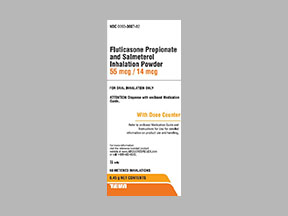
Airduo Respiclick 55/14 Coupons & Savings Card – Discount Prices from $70.51
Brand for: Fluticasone-salmeterol
This product is used to control and prevent symptoms (wheezing and shortness of breath) caused by asthma. It contains 2 medications: fluticasone and salmeterol. Fluticasone belongs to a class of drugs known as corticosteroids. It works by reducing the irritation and swelling of the airways. Salmeterol belongs to a class of drugs known as long-acting beta agonists. It works by relaxing the muscles around the airways so that they open up and you can breathe more easily. Controlling symptoms of breathing problems can decrease time lost from work or school. When used alone, long-acting beta agonists (such as salmeterol) may rarely increase the risk of serious (sometimes fatal) asthma-related breathing problems. However, combination inhaled corticosteroid and long-acting beta agonists, such as this product, do not increase the risk of serious asthma-related breathing problems. This product should be used when breathing problems are not well controlled with one asthma-control medication (such as inhaled corticosteroid) or if your symptoms need combination treatment. Before using this medication, it is important to learn how to use it properly. This medication must be used regularly to be effective. It does not work right away and should not be used to relieve sudden asthma attacks. If an asthma attack occurs, use your quick-relief inhaler (such as albuterol, also called salbutamol in some countries) as prescribed.
Our Airduo Respiclick 55/14 coupons are free to use. You can print the coupon, email it to yourself, or receive the Airduo Respiclick 55/14 coupon via text message. To get your free discount, show the pharmacist your Airduo Respiclick 55/14 savings card which has the discounted coupon price. Use our filters below to edit the prescription box to match your needs. The Airduo Respiclick 55/14 prices will update based on your prescription needs. Above our Airduo Respiclick 55/14 coupons, you can change the location to see pharmacy prices in other areas. Our prescription discount card will update online with the specific pharmacy costs associated with your edits. Be sure to text, email, or print the Airduo Respiclick 55/14 savings card code that you need after editing the prescription box and location field. Show the discount card to your pharmacist before paying.
My prescription
Edit
55-14MCG/ACT, Fluticasone-salmeterol (1 Aerosol Powder Breath Activated)
Select pharmacy

CVS
$70.51
COUPON PRICE
Walgreens
$88.88
COUPON PRICE
Walmart
$112.21
COUPON PRICE
Albertsons
$126.37
COUPON PRICEAirduo Respiclick 55/14 savings card
Show this card to your pharmacist
CVS
$70.51
BIN
ID
PCN
GRP
019876
LHECCA101E
CHIPPO
LHX
Powered by
This product is used to control and prevent symptoms (wheezing and shortness of breath) caused by asthma. It contains 2 medications: fluticasone and salmeterol. Fluticasone belongs to a class of drugs known as corticosteroids. It works by reducing the irritation and swelling of the airways. Salmeterol belongs to a class of drugs known as long-acting beta agonists. It works by relaxing the muscles around the airways so that they open up and you can breathe more easily. Controlling symptoms of breathing problems can decrease time lost from work or school. When used alone, long-acting beta agonists (such as salmeterol) may rarely increase the risk of serious (sometimes fatal) asthma-related breathing problems. However, combination inhaled corticosteroid and long-acting beta agonists, such as this product, do not increase the risk of serious asthma-related breathing problems. This product should be used when breathing problems are not well controlled with one asthma-control medication (such as inhaled corticosteroid) or if your symptoms need combination treatment. Before using this medication, it is important to learn how to use it properly. This medication must be used regularly to be effective. It does not work right away and should not be used to relieve sudden asthma attacks. If an asthma attack occurs, use your quick-relief inhaler (such as albuterol, also called salbutamol in some countries) as prescribed.
Our Airduo Respiclick 55/14 coupons are free to use. You can print the coupon, email it to yourself, or receive the Airduo Respiclick 55/14 coupon via text message. To get your free discount, show the pharmacist your Airduo Respiclick 55/14 savings card which has the discounted coupon price. Use our filters below to edit the prescription box to match your needs. The Airduo Respiclick 55/14 prices will update based on your prescription needs. Above our Airduo Respiclick 55/14 coupons, you can change the location to see pharmacy prices in other areas. Our prescription discount card will update online with the specific pharmacy costs associated with your edits. Be sure to text, email, or print the Airduo Respiclick 55/14 savings card code that you need after editing the prescription box and location field. Show the discount card to your pharmacist before paying.
Our Airduo Respiclick 55/14 coupons are free to use. You can print the coupon, email it to yourself, or receive the Airduo Respiclick 55/14 coupon via text message. To get your free discount, show the pharmacist your Airduo Respiclick 55/14 savings card which has the discounted coupon price. Use our filters below to edit the prescription box to match your needs. The Airduo Respiclick 55/14 prices will update based on your prescription needs. Above our Airduo Respiclick 55/14 coupons, you can change the location to see pharmacy prices in other areas. Our prescription discount card will update online with the specific pharmacy costs associated with your edits. Be sure to text, email, or print the Airduo Respiclick 55/14 savings card code that you need after editing the prescription box and location field. Show the discount card to your pharmacist before paying.
Airduo Respiclick 55/14 FAQs
Using the SaveHealth discount card, what is the price of Airduo Respiclick 55/14 without insurance?
Using the SaveHealth discount card, the price of Airduo Respiclick 55/14 without insurance is $70.51.
What is the price of Airduo Respiclick 55/14 at CVS?
The price of Airduo Respiclick 55/14 at CVS is $70.51.
What is the price of Airduo Respiclick 55/14 at Walgreens?
The price of Airduo Respiclick 55/14 at Walgreens is $88.88.
What is the price of Airduo Respiclick 55/14 at Walmart?
The price of Airduo Respiclick 55/14 at Walmart is $112.21.
